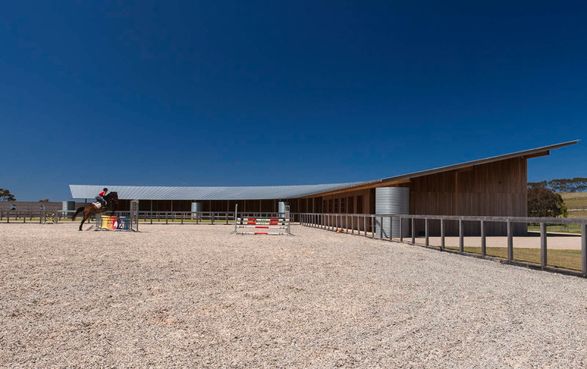Equestrian Buildings
ARCHITECTS
Seth Stein Architects, Watson Architecture+design
PHOTOGRAPHS
Lisbeth Grosmann
YEAR
2014
LOCATION
Merricks, Australia
CATAGORY
Stable
Text description provided by architect.
Located amidst farmland and vineyards on the Mornington Peninsula, south of Melbourne, Seth Stein Architects (UK) and Watson Architecture + Design (Melbourne) were commissioned to design a new equestrian centre.
The client is based locally as well as in the UK and sought a scheme that whilst functional and practical would also be sympathetic to the landscape through its architectural form and use of materials intended to be durable and sustainable.
In terms of cultural context an equestrian building is a recognisable characteristic of the region. It was necessary however to locate the buildings on level terrain, in particular to accommodate the menage covering 3000m/sq, within an undulating landscape.
Extensive landscaping works were required to stabilise and drain the land that provided the opportunity to create a small reservoir lake containing a bird island sanctuary.
The building is arranged in a crescent plan that provides enclosed stables for 6 horses, wash, tack and laundry, workshop and feed as well as a small office and grooms’ accommodation.
A barn wing provides straw and hay storage and parking for the stables vehicles. Externally there is a small pool for the horses, day yards (hard and grass) as well as the menage for event practice and jumping.
The crescent shape provides a relatively compact plan with all the activities focused towards a central area being the stables arcade overlooking the grass day yards.
The rear perimeter wall, constructed in rammed earth, a method of natural earth and concrete construction found in the region, culminates in the shallow pool that is replenished by a fountain spout and offering the horses a cool drink.
The palate of building materials is restricted to a minimum: seen from a distance the building is strongly delineated by the arcing monopitch of the zinc roof in the form of a ‘J’. The roof itself is used as an enclosing and sheltering element, beneath which the rear rammed earth wall extends independently beyond the building footprint.
The third building element is the timber structural frame, made from laminated plantation Tasmanian Oak, and cladding panels, made from Class One, Spotted Gum, that share the same modular dimension. They are beginning to fade to silver next to the grey tones of the rammed earth wall.
As a response to the extremes of weather that the region encounters it was decided to harvest and retain rainfall via the 1260m/sq roof as well as large in underground storage tanks. These in turn feed the reservoir pond.
The monopitch cross section of the building provides natural ventilation as well as shading in the summer months and low horizon sun penetration in the winter.
















